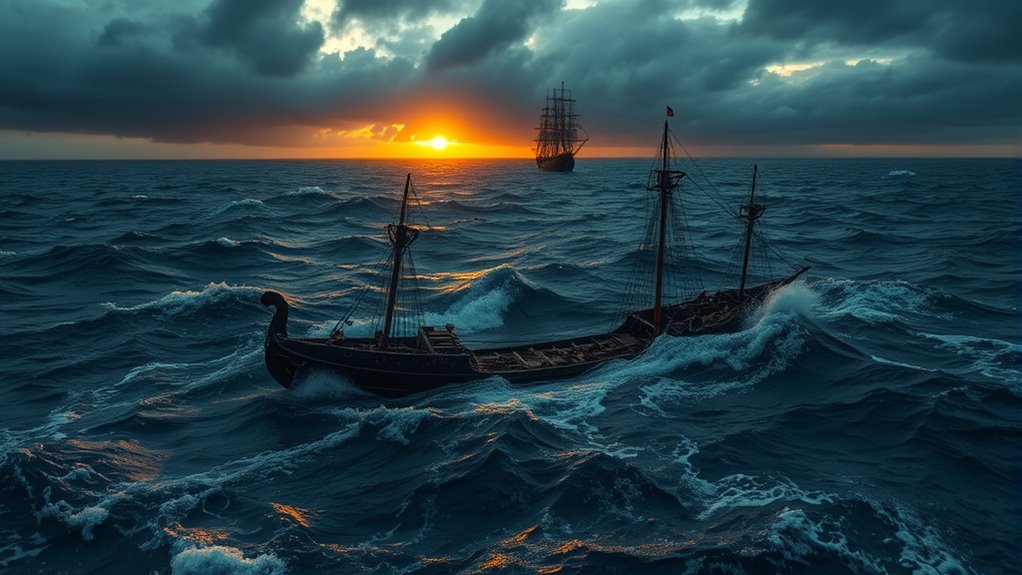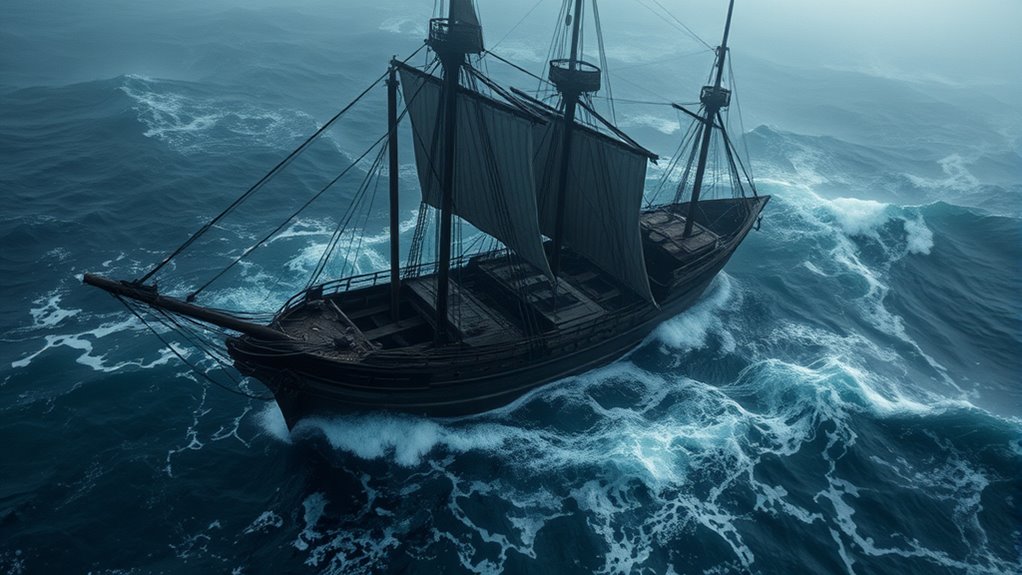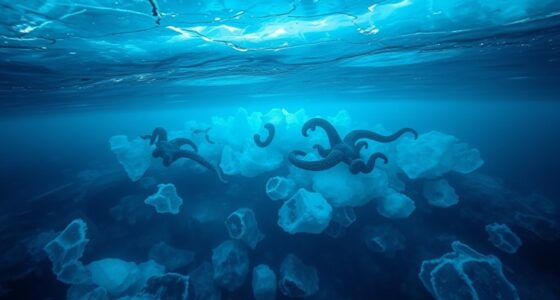Forensic oceanography has shown that powerful ocean currents played a key role in the Mary Celeste’s mysterious disappearance. By analyzing ship logs, weather data, and current patterns, experts found that natural forces could have misled navigators and moved the vessel off course. This scientific approach replaces old theories of piracy or mutiny with a natural explanation. Curious how these currents shaped the ship’s fate? Keep exploring to uncover the full story.
Key Takeaways
- Forensic oceanography utilizes current analysis to trace Mary Celeste’s last known trajectory and possible displacement by ocean currents.
- Natural forces, such as unpredictable ocean currents, are now viewed as primary factors behind the ship’s abandonment.
- Reconstruction of the ship’s final movements shows currents could have carried it far from its last position.
- The approach combines maritime archaeology, weather data, and current overlays to differentiate natural causes from foul play.
- Scientific explanations based on oceanography help resolve the century-old mystery, moving beyond speculation to natural process understanding.

For centuries, the fate of the Mary Celeste has puzzled historians and maritime enthusiasts alike. This mysterious ship, found abandoned in the Atlantic in 1872, sparked countless theories about piracy, mutiny, or supernatural phenomena. But today, forensic oceanography offers a new perspective, shedding light on what truly happened. By combining maritime archaeology with advanced ocean current analysis, experts can piece together the ship’s last movements and the forces at play in its disappearance. You might not realize it, but understanding ocean currents is essential for solving maritime mysteries like this. These currents, which flow beneath the ocean’s surface, can carry ships hundreds of miles off course, sometimes in unpredictable ways. So, when examining the Mary Celeste’s final voyage, forensic oceanographers analyze historical weather data, ship logs, and the ship’s last known position, then overlay this information with current patterns. This approach reveals how a sudden change in ocean currents could have pushed the vessel off its intended route while crew members, perhaps startled by rough seas or a sudden storm, abandoned ship under stressful circumstances. Additionally, the variability of dynamic ocean currents plays a crucial role in such scenarios.
Maritime archaeology plays an integral role here, as it allows researchers to study physical evidence from shipwrecks, including the Mary Celeste’s last known location and any artifacts recovered nearby. This helps establish a timeline and context for the ship’s disappearance. When combined with ocean current analysis, it provides a clearer picture of how natural forces, rather than foul play or supernatural causes, might have led to the crew’s sudden departure. You see, currents can create misleading signals on navigational instruments, making a ship appear elsewhere than its actual position. They can also cause distress or damage to the vessel, prompting crew members to abandon ship in a panic. By reconstructing the ship’s last moments and considering the influence of ocean currents, forensic oceanographers can explain why the Mary Celeste was found deserted and why its crew disappeared without a trace.
In essence, this scientific approach moves the mystery from speculation to explanation. It underscores how natural ocean processes, rather than sinister plots, might have driven the crew to leave the ship behind. You now understand that forensic oceanography, with its focus on maritime archaeology and ocean current analysis, provides a powerful toolset to demystify maritime mysteries. It’s a reminder that the ocean’s vast and dynamic nature holds many secrets, but through scientific inquiry, we can uncover the truth behind even the most enduring maritime enigmas.
Frequently Asked Questions
Were Any Crew Members Ever Found After the Disappearance?
You wonder if any crew members were ever found after the disappearance. In ghost ships like the Mary Celeste, maritime legends suggest the crew vanished without a trace, fueling mysteries and speculation. Despite numerous searches, no bodies or survivors were ever discovered, leaving the true fate of the crew unknown. The story continues to captivate, reinforcing the eerie reputation of ghost ships and the enduring enigma surrounding such maritime legends.
What Specific Forensic Techniques Were Used in the Oceanographic Analysis?
You’ll find that forensic oceanography employs advanced techniques like underwater drones to explore wreck sites and gather visual evidence. Chemical analysis plays a vital role, helping identify substances like blood or fuel residues, which can reveal what happened aboard. These methods allow you to reconstruct events accurately, providing insights into the ship’s final moments and contributing to the resolution of maritime mysteries like the Mary Celeste.
How Did Weather Conditions Influence the Event’s Outcome?
You see, weather conditions, especially a sudden storm or unusual weather pattern, can drastically impact nautical navigation. When such patterns develop unexpectedly, they can cause ships to lose their way, become disoriented, or even capsize. In the case of the Mary Celeste, changing weather likely played a role by creating chaos at sea, influencing the crew’s decisions and ultimately contributing to the mysterious event’s outcome.
Are There Modern Similar Maritime Mysteries?
Imagine ghostly ships drifting under stormy skies, their silhouettes fading into the mist—modern maritime mysteries still captivate us. You might wonder about unexplained disappearances in today’s seas, echoing maritime folklore and historical shipwrecks. While technology aids investigation, some cases remain elusive, shrouded in mystery like ancient tales. These unresolved incidents remind you that the ocean’s depths still hold secrets, challenging even the most advanced maritime explorers.
Could Piracy Have Been Involved in the Incident?
You wonder if piracy suspicion could explain the crew disappearance on the Mary Celeste. While pirates might be involved in some maritime mysteries, evidence for piracy in this case is limited. The crew’s sudden absence suggests other possibilities, like a sudden storm or onboard accident. Without concrete signs of piracy suspicion, it’s more likely that natural causes or internal issues caused the crew’s disappearance rather than external piracy threats.
Conclusion
Now that you’ve uncovered the secrets behind the Mary Celeste, it’s clear that forensic oceanography acts like a lighthouse guiding us through the murky waters of mystery. Just as a lighthouse illuminates the unseen, this science reveals hidden truths beneath the waves. So next time you wonder about maritime enigmas, remember—sometimes, the truth is just waiting beneath the surface, ready to be uncovered, if only you know where to look.









